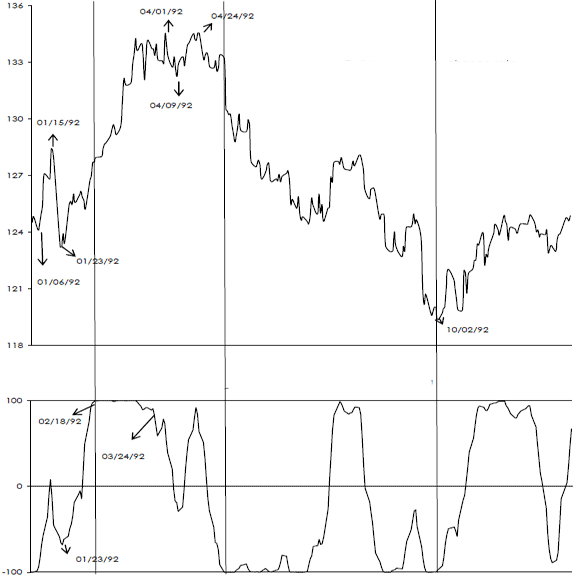Is the aggregate effect of technical trading visible and exploitable in currency exchange rate trading? In his 2008 paper entitled “Aggregate Trading Behaviour of Technical Models and the Yen/Dollar Exchange Rate 1976-2007”, Stephan Schulmeister investigates the interaction between the aggregate signaling of 1,024 moving average and momentum rules and the behavior of the yen/dollar exchange rate. Using daily yen/dollar exchange rate data over the period 1976-2007, he finds that:
- Over the 1976-2007 sample period, the 1,024 technical rules generate an average annual gross return of 8.5%, with the worst rules still profitable at 5.4%. The number of losing trades exceeds the number of winners, and the average absolute daily return is higher for losing trades than winners. Overall profitability derives exclusively from the fact that winning trades last about three times longer than losers. (See the author’s companion 2007 paper entitled “Performance of Technical Trading Systems in the Yen/Dollar Market” for details.)
- Technical trading in aggregate often exerts up or down pressure on the yen/dollar exchange rate because technical rules produce reinforcing clusters of long or short trading signals.
- The phases of the signal aggregation process are (see the figure below):
- News triggers a price trend up or down initiated by traders who key on economics or politics.
- After one to three days, trend-following rules start to generate a sequence of signals over a period of ten to 20 days that reinforce the trend (if uninterrupted by “new” news), as though the technical traders were herding.
- After 90% of the rules have signaled, the exchange rate continues to trend over subsequent days, perhaps due to amateurs jumping on the bandwagon. These latecomers are the enablers of successful technical trading and probably the biggest losers in exchange rate trading.
- Once trends lose momentum, contrarian technical rules contribute to onset of reversal.
- More than 95% of the rules hold a long (short) position during about 22.3% (22%) of the days over the entire sample period. In contrast, rules roughly balance between short and long only about 4% of the time.
- Technical trading strongly clusters such that about 70% of all days are “quiet” (less than 5% of rules signaling).
The following chart, taken from the paper, relates the behavior of the yen/dollar exchange rate in the upper graph to the aggregate position of the 1,024 technical trading rules from 100% long (100) to 100% short (-100) in the lower graph during 1992. Due to a prior dollar depreciation, all rules are short the dollar at the beginning of the year. The dollar appreciation during January 6 to 15 causes roughly half of the rules to flip from short to long. The subsequent reversal induces roughly 30% of the rules to flip from long to short. The ensuing strong and extended dollar appreciation flips nearly all rules to long between February 18 and March 24. During the extended dollar depreciation between April 24 and October 2, the rules are mostly short.

In summary, technical trading rules in aggregate generate positive feedback that strengthens and lengthens exchange rate trends and are thus destabilizing. The continuation of trends after most or all rules have “flipped” suggests a bandwagon effect from other traders. Monitoring technical models helps form expectations about the expectations of other traders.
Note that:
- The author suggests that understanding and quantifying the aggregate technical trading trend feedback mechanism is useful to traders, but the paper offers no test of usefulness.
- More recent data would be interesting. As noted in “Aggregate Technical Trading and Stock Market Behavior”, the author’s research on equities indicates that technical trading interactions may have accelerated to speeds not revealed by a daily measurement interval.
This paper extends the author’s 2001 research with similar findings for the DM/dollar exchange rate as documented in “Profitability and Price Effects of Technical Currency Trading”.